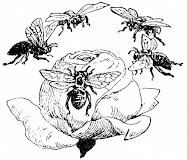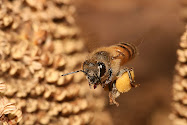BEE'S EYE VIEW . . . by Mary Anne Watson

Photo: Muhammad Mahdi Karim - see (1) below
The life cycle of Apis mellifera
"There was an Old Lady who lived in a shoe,
She had so many children she didn't know what to do!"
So the nursery rhyme begins that all children can recite by heart, even before they can read. Ever wonder how that "Old Lady" kept so many children inside that shoe? Well, long before that nursery rhyme was written, Apis mellifera (the scientific name for the honey bee) had everything figured out.
The queen bee is the original lady in the shoe, but she lives in a hive with her many thousands of children. Yes, thousands!
Every honey bee begins its life as a tiny egg. This is the first of three stages, or different appearances, that the bee will have before it will look like what is a typical honey bee. Each new egg has its own little room in the hive called a cell. The eggs look like a tiny grain of white rice inside the cell. That's a lot of rooms when you think about the queen laying as many as 1,500 eggs a day!
After about 3 days, the egg begins to develop into a glistening white larva. This is the second stage. At first, the larva looks like a small letter "C" lying at the bottom of the cell. Here the larva is cared for by other bees.
Everything the larvae need is given to them; they just lie around glistening and looking spectacularly white. After about 6 days the caring bees seal the cell with the larva inside. The cap is made from beeswax. So while the cell is sealed or capped the larva stretches itself out lengthwise and spins a thin silken cocoon. Now the magic begins. Inside the capped cell the larva changes its form to an adult honey bee. The compound eyes begin to appear - big, round and brownish purple. Then the body begins to gradually take on the form of the adult bee that we all know and love. All of this magic takes roughly 8 to 14 days.
Mother's Day may be Swarm Day
From the beginning of their existence the queen bee and all her children have known exactly what to do when the hive becomes too crowded. They wait for a perfect day to travel and find a new home that will accommodate their numbers.
A perfect day is typically sunny and warm, and when the bees make up their minds to leave (swarm) there is no stopping them.
When this happens, the queen and her children leave the hive. For a few minutes they will fly somewhere near the hive, but then they all leave and fly high into a tree or possibly to a roof top. The children will stay with their mother (the queen) and find a safe secure place to begin building a new hive.
So, while May is the month for celebrating Mother's Day all around the world, it seems fitting that it is also a month when bees throughout the country will swarm. Funny, nature has been celebrating motherhood long before humans ever did!
~ Page 2 ~
ABOUT THIS MONTH'S PHOTOGRAPHS & ILLUSTRATIONS:
(1) This photograph, "Apis mellifera flying," was taken by Muhammad Mahdi Karim, a Tanzanian student living in Bangalore, India. To see more close-ups of bees and other insects, visit his website at http://www.micro2macro.net/. (Note: Permission is granted to copy, distribute and/or modify this document under the terms of the GNU Free Documentation License.)
(2) The source for this illustration is My First Picture Book, by Joseph Martin Kronheim, published in New York by George Routledge and Sons in 1875.
MORE, PLEASE . . . advanced investigations . . .
Some of the best close-up photos ever of the honeybee life cycle can be found at http://beediary.wordpress.com/, the blog address for "Border Bees Diary: Diary of a Beekeeper in the Scottish Borders." Four of "borderglider's" photographs and captions are included below: please visit!
1) "Young bees building new comb" (top left)
2) "The white eggs standing-up in the centre of these cells have been laid in the last 24 hours. By the second day they will flop-over and lie down in the cells and the larvae will then hatch and begin to grow." (top right)
3) "Sealed brood, bee larvae and eggs: Sealed or 'capped' brood in upper left; the pearly white grubs are unsealed brood which are about half-grown. On the ninth day of growth they will fill the cells and be sealed-in; after this they spin a cocoon and pupate into adult worker bees." (bottom left)
4) "Brood nest of the beehive: This is one frame of four or five which make up the brood nest . . " (bottom right)


Posted by borderglider on July 11, 2009:
"May and June are wonderful months for the beekeeper, when the colonies are expanding fast, queens are laying between 1 -3000 eggs a day and the colony is expanding rapidly. It is also the time when bees reproduce by swarming – the colony divides and the old queen leaves to found a new colony – taking about half of the hive’s bees with her. The swarming impulse is usally triggered by a large population increase within the hive."
From: http://beediary.wordpress.com/, "Border Bees Diary: Diary of a Beekeeper in the Scottish Borders."







No comments:
Post a Comment